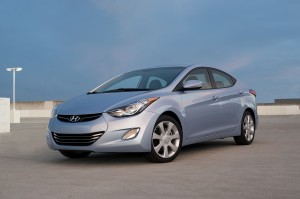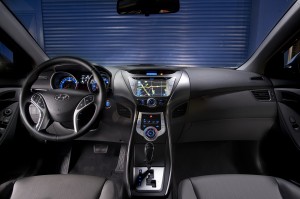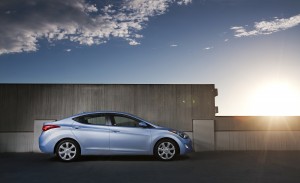Hyundai’s 2011 Elantra Trades on Space
By Eric Tegler
There are several approaches you can take in designing a compact, fuel efficient car. You can emphasize staunch (if unexciting) reliability as Toyota does with its Corolla, driving verve as Mazda and Honda do with their Mazda 3 and Civic, or an unexpected level of sophistication as Chevy and Ford do with the Cruze and the upcoming Focus. Or, as Hyundai has done with its 2011 Elantra, you can trade on size.
“Compact” cars have been growing in size for over a decade and from the driver’s seat, the new Elantra feels like a midsize sedan. The EPA agrees, formally classifying it as a mid-sizer. Among its competitors only the Nissan Sentra offers more passenger volume and no competing compact sedan offers more cargo volume. In fact, even premium midsize offerings like the Acura TSX, Nissan Maxima and VW Passat actually have less interior volume than the Hyundai.
And the new Elantra’s interior is certainly accommodating. Its design is modern with a clean blue-tinged control layout and hour-glass shaped center console dominated by an optional seven-inch touch-screen. There are multiple storage nooks in and around the dash and a handy extra power point on the passenger side of the console. Front seat legroom is best in class. We found seat comfort to be average but rear seat room is noticeably more generous than many of the Elantra’s competitors.
Hyundai has been generous with standard safety features too. The Elantra gets a complement of six airbags, rear door dual impact beams, a vehicle stability management system integrating traction control/ABS and daytime running lights.
Despite its capacious interior (95.6 cubic feet), the 2011 Elantra has grown less than an inch in length and retained the same width as the car it replaces though its 106.3 inch wheelbase is two inches longer. Due to Hyundai’s proprietary development and use of lightweight steel and other weight saving elements such as soy foam-filled seats, the new Elantra is actually 62 pounds lighter than its predecessor. Light weight translates not only to better handling but to fuel efficiency.
The Elantra’s 29 mpg city/40 highway is not only impressive in its own right but bests most of its competition. In addition to light weight, a new 1.8 liter four cylinder combines with standard six-speed automatic and manual transmissions to yield an 18 percent improvement in fuel economy. The 1.8 makes an acceptable 148 horsepower but the Elantra could use a bit more torque.
Hyundai points out that competitors with similar mpg numbers like Ford’s Fiesta and Chevy’s Cruze achieve those numbers with specific optional fuel economy packages which add a couple thousand to their sticker prices. Hyundai has opted for admirable pricing/content simplicity, making the Elantra available in only two trim levels – Limited (luxury) and GLS. Three option packages add features from 16 inch wheels to Bluetooth to the GLS while a “Premium” package for the Limited adds navigation, a rearview camera and high-end audio.
The base GLS starts at $14,830 though, disappointingly, at that price you won’t get air conditioning. Get too happy with options packages and you can run the Elantra Limited up to nearly $22,000 – a price which rather defeats the purpose of a budget-wise compact. Other off-notes included some uneven interior fitment we noticed on a couple of the Elantras we drove, a tricky clutch engage point with the manual transmission and a reverse-lock trigger on the back of the manual gearshift that takes getting used to. The Elantra’s Motor Driven Power Steering (MDPS) system may save more fuel than a standard hydraulic system but the cost is overly light and vague steering with little feedback.
Hyundai’s “Fluidic Sculpture” exterior styling definitely sets the Elantra apart from the competition and contributes to its visual impression of size. However, it so closely resembles the styling of its big-brother Sonata that it’s easy to mistake one for another.
On balance, Hyundai is to be commended for packaging considerable content and efficiency into the new Elantra though it remains a tick behind the top of the segment in overall refinement. Still, it’s just a tick. The Elantra’s bigness should more than compensate. Hyundai salespeople may want to call it “value-sized”.
The Specs
Price as tested: $14,830 – $21,980 Engine: 148 hp, 1.8 liter four cylinder Curb weight: 2701 pounds Fuel Economy: 29 city/40 highway



Leave a Reply